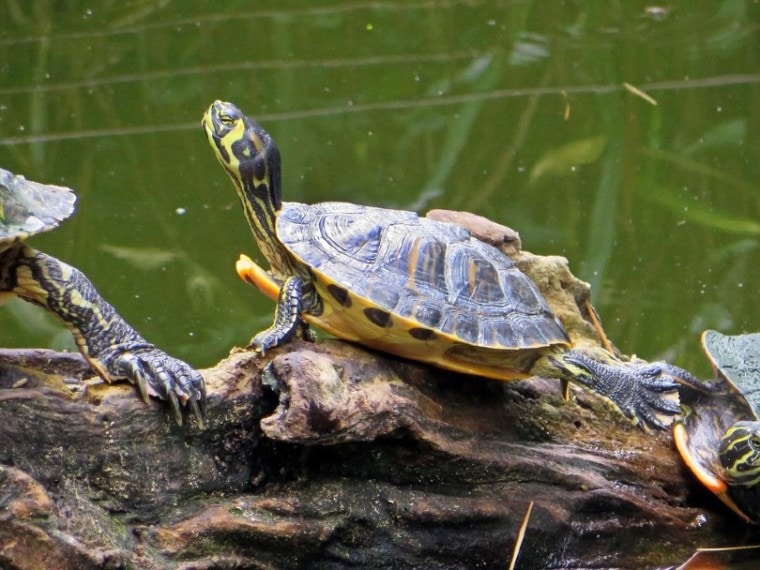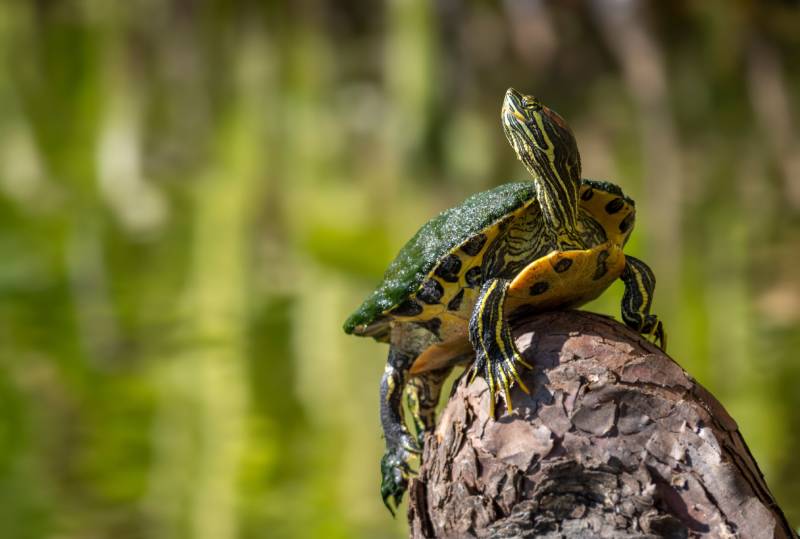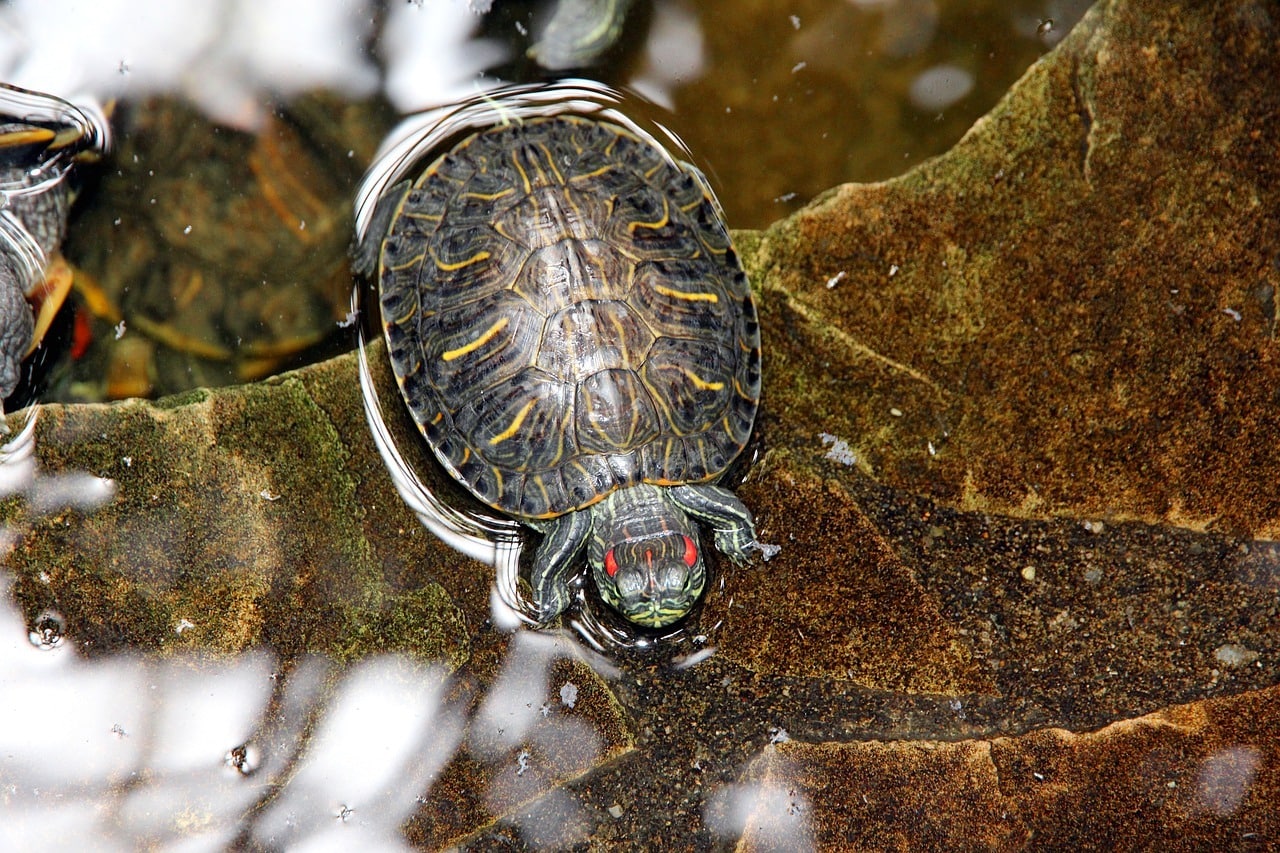
Pet turtles are popular because of how easy it is to care for them. Among this specific family of reptiles is the yellow-bellied slider, one of the most common pet turtles.
Even though these pets are easy to take care of (besides their tank maintenance), you must remember that they can live up to 40 years in captivity. They are a long-term commitment.
If you are getting ready to adopt one of these turtles, here is all that you need to know about their setup and maintenance.
Quick Facts About Yellow-Bellied Slider

| Species Name: | Trachemys scripta scripta |
| Family: | Emydidae |
| Care Level: | Easy |
| Temperature: | 75 to 80 degrees Fahrenheit |
| Temperament: | Docile |
| Color Form: | Yellow-bellied, green, dark shell |
| Lifespan: | 20 to 30 years |
| Size: | 8 to 13 inches |
| Diet: | Omnivorous |
| Minimum Tank Size: | 75 gallons |
| Tank Set-Up: | Part terrestrial and part aquatic |
| Compatibility: | High |
Yellow-Bellied Slider Overview
Yellow-bellied sliders are closely related to other popular turtles, like the red-eared slider. They have a native range throughout the southeastern U.S. but are kept as pets around the world.
These turtles are used to a wide range of environments due to their spread throughout North America. They are what ecologists call “habitat generalists.”
As a pet, they are easy to care for because they don’t need highly specific environment specifications. Their adaptability means they do well in captivity as long as you meet their basic needs.
The most significant part of this species’ continued maintenance is their tank. This turtle can grow up to 13 inches long and needs plenty of space. Their minimum tank size should be 75 gallons, and that is if you have only one turtle.
How Much Do Yellow-Bellied Sliders Cost?
It is best to adopt a yellow-bellied slider from a reputable breeder so you ensure that they are captive-bred. You don’t want a wild-caught slider because they aren’t likely to adapt as well to a captive environment. They will also appreciate handling even less than captive-bred turtles.
On average, you can expect to pay between $10 to $20 for a yellow-bellied hatchling slider. Adult turtles cost more because of the survivability rate of a hatchling. Adults cost between $60 and $100.

Typical Behavior & Temperament
Almost all slider turtles, including the yellow-bellied slider, are diurnal turtles. That means they are most active during the day. That makes them an exciting reptile to watch because there are plenty that are only nocturnal.
Turtles tend to eat right away in the morning and then spend most of the remaining sunlit hours basking.
It is good for new turtle owners to realize that their turtle will never end up being cuddly like a pet puppy. When they feel threatened, they will probably bite. You are more likely to get a more docile turtle when you adopt a captive-bred specimen from a breeder.
Over time, you can build up your turtle’s tolerance for handling. However, be aware that they never prefer it.
Appearance & Varieties
There are many different kinds of sliders and even more variety when talking about turtles in general. However, there is only one kind of color pattern for this specific breed.
A yellow-bellied slider has an apt name due to the coloration on the bottom of their shell, called the plastron. Their plastron is covered in bright yellow and has black spots.
The top of this turtle’s shell is called a carapace. On this turtle, it has a subdued color palette. It usually is black or dark brown. There might be vibrant yellow markings that add further visual interest.
The actual body of the turtle is quite interesting as well. They have yellow and black striping all over their skin, with patterns that typically meet at their nose.
This turtle’s feet are also engaging and demonstrate their amphibious nature. Their feet have long claws for helping them crawl around on land. Beneath those, they have webbed toes that make them excellent swimmers.

How to Take Care of Yellow-Bellied Slider
Habitat, Tank Conditions & Setup
Before you adopt a yellow-bellied slider, you should have their enclosure wholly set up and ready to go. It is the most influential part of their lives, and without the proper setup, they can quickly become quite ill.
Tank Setup
The minimum tank size for a single yellow-bellied slider is 75 gallons. If you intend on having more than one, you should add at least 10 gallons to that size. They need to have plenty of space to move around, even if they seem pretty stationary.
You need to provide a basking dock and plenty of clean water for your turtle. If you plan on breeding your turtle, you need to extend their basking area to include a nesting place.
Temperature
Turtles are cold-blooded creatures. They need help regulating their body temperature.
On an indoor tank, you need to replicate the conditions that a sunny outdoor basking spot would have. These areas should reach between 80 to 100 degrees Fahrenheit. Their water temperature should remain at a constant temperature between 75 and 80 degrees Fahrenheit.
You can maintain their enclosure’s temperature using a water heater and a 60- to 100-watt basking bulb. Since turtles also need to get UV rays for proper development, you should pair this setup with a mercury vapor bulb. These provide both the necessary UV and heat.

Lighting
Turtles have to have UVA and UVB rays to maintain their health. As long as you use a sun lamp or place their enclosure in an area that receives unfiltered sunlight, they should be fine.
Aquatic turtles like the yellow-bellied slider need this UV light year-round for about 12 hours each day. The effectiveness of the bulb degrades as it changes. Replace the bulb every 6 months to maintain its strength.
For turtles that live outdoors, the sun’s rays are sufficient for them.
Aquatic Area
Sliders need a large enough aquatic area in their tank for them to be able to dive into it. Since these turtles both eat and leave fecal matter in their aquatic homes, it can be challenging to keep them clean. However, having a consistent supply of clean water is essential for their health.
Use canister or submersible biological filters to help you keep the tank clean during the week. It is highly suggested that you do a partial water change and quality test at least once a week. At least once a month, completely clean and change the water in their aquatic area.
If you feed your turtle outside of their enclosure, the quality of their water will degrade exponentially slower.
You can also use an outdoor pond as long as you have a secure border around your yard. That helps keep your turtle in and any predators out.
Do Yellow-Bellied Sliders Get Along With Other Pets?
You should keep your yellow-bellied slider away from any other pets you have unless it is another turtle. A yellow-bellied slider can safely be paired with another yellow-bellied. You can also pair their cousin, the red-eared slider, with them.
Even when you keep your turtles together, you should always keep turtles of about the same size in the same container. They should be no more than a few inches bigger than the other. Otherwise, if they fight, the larger one is likely to injure the smaller one.
These turtles frighten easily. If another pet tries to contact them, they will either hide or bite the other animal. If they get scared too often, they won’t feel safe and have a healthy lifestyle in their enclosure.
What to Feed Your Yellow-Bellied Slider
Turtles are omnivores. They need to get a wide variety of plant-based foods with a bit of animal protein, typically from fish. You can get commercial turtle pellets to feed them a complete and nutritious base diet. However, it is best to supplement these with a variety of other fresh foods.
Some of the best things to give your turtle are dark, leafy greens. These include plants like dandelion greens, romaine, and fresh parsley. All these things can be a regular part of a yellow-bellied slider’s diet. You can even give them treats, like a chopped apple or freeze-dried shrimp, once a week.
Feed a turtle that is younger than 2 about twice a day, evenly spread throughout the day. Once they become adults, around age 2, they should eat only once each day.
Many turtle owners recommend that you feed your turtle outside of their tank. It will help keep it cleaner, although it is a bit more work. Remove anything that they haven’t eaten in about 15 to 20 minutes.
Keeping Your Yellow-Bellied Slider Healthy
Since a slider should always have enough room to dive into their water and stay submerged, it is not always a good sign if they are floating. They could have a disease like pneumonia.
Keep an eye on these turtles’ eyes and their breathing if you can. Puffy eyes or wheezing indicates some kind of respiratory infection. You should take them to the vet immediately if you notice this.
The health of a shell often indicates the health of the turtle. Their shells shouldn’t be soft. Instead, they should be smooth. If it is covered in algae, it is a sign of shell rot and can be painful. As long as your turtle has enough space to move around, this shouldn’t happen.
Finally, metabolic bone diseases are also quite common. These can come from inappropriate diets or lack of proper lighting. Ensure that your heat lights and UVB are changed regularly to keep your turtle in top shape. These diseases are painful and life-threatening for turtles.
Breeding
Keeping males and females together is the best way to get the turtles to mate eventually. You have to wait until they are sexually mature, and even then, it can be challenging to get them to mate until they are ready.
Females are typically sexually mature when they are about 4 inches long, although there are exceptions to this rule. Males tend to mature faster because they don’t usually grow as large as female yellow-bellied sliders.
When these turtles mate, they will be in the water. The male uses his claws to create patterns in front of the female to entice her to mate. If the female wants to, she will sink to the bottom of the enclosure to let the male mount her.
These turtles typically mate in the spring. Then, if it was successful, they will lay their eggs in either late June or early July. At that point, you need a safe space for the female to dig. She will lay a nest of anywhere from 20 to 60 eggs. Then, she will cover them in vegetation.
The eggs incubate for 60 to 65 days, generally hatching in mid-August. There are many yellow-bellied sliders in the rescue and adoption system, so unless you have a reliable source of people who want these turtles, it isn’t recommended for you to let the eggs hatch.
Are Yellow-Bellied Sliders Suitable for You?
Yellow-bellied sliders are low-maintenance pets as long as you work hard to keep their enclosure clean. They are a long-term commitment, living for up to 40 years in captivity. If you are ready to commit to that lifespan, these turtles make excellent pets without being needy on a daily basis.
Read Also:
Featured Image Credit: DEZALB, Pixabay








